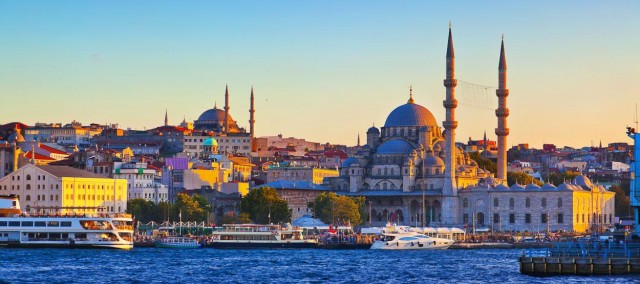Istanbul
THE CITY OF ISTANBUL in TURKEY has one of the most interesting and important physical locations of any sity in the world, the crossroads of TRADE ROUTES by both water and land. It is the only city to straddle two continents, Europe and Asia, and has been at the center of regional commerce for nearly 3,000 years. As Constantinople, it was the most important city in the Western world after the fall of the Roman Empire in the West and was then transformed into the political center of the OTTOMAN EMPIRE, which dominated the eastern Mediterranean until its demise 1923.
The western bank of the Bosporus, the narrow channel connecting the BLACK SEA and the Sea of Marmara, was first settled about 3,000 B.C.E. At its narrowest, the Bosporus is only 2,640 ft (800 m) wide, an ideal location for a settlement to participate in and control any and all trade passing between the Black Sea and the MEDITERRANEAN. Greek colonists established cities on both sides of this channel in the 7th century B.C.E., Chalcedon on the east side, and a city named for one of their early leaders, Byzas, on the west bank. This city, taking the name Byzantium, was built above the finest natural harbor on the Bosporus, a narrow inlet called the Golden Horn because of its curved shape and the amount of wealth that flowed across its piers. This is the heart of today's Istanbul and forms the northern boundary of the old city. Called Halic in Turkish, and Keration in Greek, the six-mile-long Golden Horn dominated shipping then, as it does today. The city grew wealthy by charging tolls from any ship passing through the narrows of the Bosporus.

Byzantium remained a fairly minor city until the 4th century C.E., when Roman emperor Constantine the Great chose the city as his new capital. Constantinople reached the height of its intellectual sophistication and architectural grandeur in the 6th century, under Emperor Justinian, who constructed some of the grandest buildings in the world, including the Church of Hagia Sophia (“Holy Wisdom”), the largest church in Christendom. After nearly eight centuries of continual attacks, Constantinople fell to the Ottoman Turks in 1453 and became the center of Ottoman power in the eastern Mediterranean. While retaining the name Constantinople officially (Qostantiniyeh in Turkish), gradually the city began to be called Istanbul (or Stambul) locally, a corruption from the Greek words for “to the city.” It was also sometimes known to the Turks as Dersaadet, “Abode of Felicity,” known for its luxurious palaces and lush gardens. The Turkish sultans ruled a city whose climate was indeed felicitous, warm and not too dry, suitable for the extensive gardens that came to dominate much of the old city within the walls, known as the Surici. The city continued to thrive, with a population of about 500,000 in 1500.
Today, Istanbul is the principal city of Turkey, though it ceased to be the capital after the fall of the OTTOMAN EMPIRE in 1923. With a population exceeding 9 million, Istanbul ranks among the top 10 largest cities in the world. Istanbul is the capital of a vilayet (province) of the same name—officially changed from Constantinople only in 1930. The city has three main divisions: Old Istanbul (the city within the ancient and medieval walls), Galata-Beyoglu across the Golden Horn, and the Asian Quarters across the Bosporus. The city is more heterogeneous than the rest of Turkey, with some of its quarters dominated by specific minorities: Greeks, Armenians, and others.
Istanbul proper encompasses a peninsula between the Golden Horn and the Sea of Marmara to the south, from the old wall across the end of the peninsula in the west, to Sarayburnu (Palace Point) in the east. Where once there was a sea wall, Ottoman sultans built several elaborate palaces and gardens, the most famous being the Topkapi Palace, which is today one of the city's major museums and tourist attractions.
FAMOUS MOSQUES
The terrain for most of the city is very hilly, with mosques and funeral monuments built to crown most of the primary hills: the most famous mosques include Mehmet II and Yeni Cami (New Mosque). The main thoroughfare is the Divan Yolu, from the Hagia Sophia to the Bayezid II Mosque. Other tourist sites include the twin fortresses of Anadolu (“Asia”) and Rumeli (“Europe”) built by the Turks on the shores of the Bosporus just before the conquest and the vast covered markets. The quarter of Eyup, the supposed site of the tomb of the Prophet Mohammed, was for centuries the site of royal ceremonies and burials.
Galata-Beyoglu, on the northern shore of the Golden Horn, was historically the residence of foreign merchants, and is today the center of modern Istanbul, with its largest shops and hotels. Across the Bosporus lie the Asiatic Quarters connected to the European side by two major suspension bridges. Smaller residential and industrial towns line the Bosporus on both sides, and along the northern edge of the Sea of Marmara, a sector of beach resorts and summer homes.